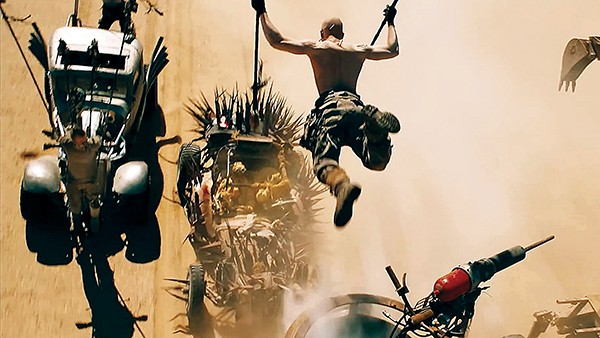I was going to start this review with an extended riff on how the thread of apocalyptic science fiction in novels like Walter M. Miller Jr.’s A Canticle for Leibowitz and J.G. Ballard’s The Drowned World found its ultimate cinematic expression in George Miller’s Mad Max (1979), The Road Warrior (1981), and Mad Max: Beyond Thunderdome (1985), but you know what? Forget that. Just go see Mad Max: Fury Road.
I was going to title this review “Punk’s Sistine Chapel,” which is what Ballard called The Road Warrior, but never mind that. I figure going on about the web of symbolism and allegory woven into George Miller’s first visit back to the blasted Australian outback in 30 years would obscure the central question in many readers minds: Does stuff blow up good?
Stuff blows up. Real. Good.
And it’s real stuff, really blowing up. It’s not that there’s no CGI in Fury Road. It’s just that Miller sees it as just another tool in a toolbox that also includes armies of stunt drivers piloting a fleet of custom vehicles, many of which are on fire at any given time.

Mad Max: Fury Road
Miller, cinematographer John Seale, production designer Colin Gibson, and editor Margaret Sixel have composed a symphony of revving engines, crashing metal, and thundering reports. Unlike most action movies made since The Bourne Ultimatum, Fury Road doesn’t try to disorient you. Quite the opposite: Miller is a master of creating a space inside your head that feels real, then hurtling you through the space in the most exciting way possible. He has exposed most Hollywood action directors as highly paid frauds. Miller’s not here to slap a bunch of disjointed images on the screen, throw millions of marketing dollars to persuade an audience that dreck is acceptable, and chalk it up as a success. Miller delivers an object of pure cinema that wouldn’t work as a novel, a comic book, or a video game. He uses exquisitely detailed images and minimal dialog to carefully parcel out just enough information at just the right time to keep you emotionally engaged in the mayhem on the screen. Actions have consequences, effect follows cause. When people get hit, they get hurt. The world feels real. There’s a guy suspended from cords on the front of a giant war truck playing metal riffs on a guitar that shoots fire, and he fits right in.
Seriously, you should see this movie.
And then there’s Charlize Theron. Her Imperator Furiosa is a woman of few words but limitless steely gazes. She’s somewhere between Sigourney Weaver’s Ripley from Alien and Clint Eastwood in A Fistful of Dollars. There’s no shortage of good performances, including Nicholas Hoult as paint-huffing bezerker Nux, Mad Max veteran Hugh Keays-Byrne as warlord Immortan Joe, and Riley Keough (who is Elvis’ granddaughter in real life) as Capable, one of the five sex slaves whose rescue provides the story’s catalyst. But Theron just flat out steals the show.
I know it probably feels like I’m laying it on a little thick for what is essentially a big car chase movie, but when I left the theater I felt like a starving man who had just been fed a steak. It’s a rare film that engages the mind while rocking the body. Miller’s vision of a world consumed by its own greed, where water, gasoline, and bullets are the most precious commodities, seems even more relevant today than it did 30 years ago. In 2015, armies of men in makeshift war machines crafted by hand from Toyota trucks really do fight over basic resources in places like Syria, Chechnya, and Mali. ISIS, a reactionary, apocalyptic religious cult led by a divinely inspired warlord, looks a lot like Immortan Joe and his War Boys. It’s Mad Max’s world, we just live in it.
Why are you still here? Go see Fury Road!